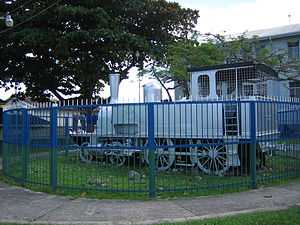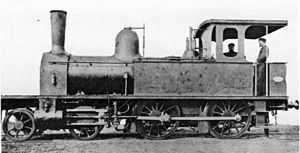Natal Railway 4-4-0T Perseverance
| Natal Railway 4-4-0T Perseverance to NGR 4-4-0T Perseverance | |
|---|---|
|
Perseverance circa 1876 | |
| Type and origin | |
| Power type | Steam |
| Designer | Kitson and Company |
| Builder | Kitson and Company |
| Serial number | 2037 |
| Build date | 1875 |
| Specifications | |
| Configuration | 4-4-0T "American" [1] |
| Gauge | 4 ft 8 1⁄2 in (1,435 mm) broad gauge |
| Leading wheel diameter | 33 in (838 mm) |
| Driver diameter | 51 in (1,300 mm) |
| Wheelbase | 18 ft 4 in (5.588 m) |
| Axle load | 10 long tons (10.2 t) on 1st driver |
| Weight on drivers | 19.9 long tons (20.2 t) |
| Locomotive weight | 27.9 long tons (28.35 t) |
| Fuel type | Coal |
| Fuel capacity | 12⁄20 long ton (0.6 t) |
| Water capacity | 494 imp gal (2,250 l; 593 US gal) |
| Boiler |
3 ft 3.5 in (1.003 m) diameter 9 ft 9 in (2.972 m) length 5 ft 11 1⁄8 in (1.807 m) pitch |
| Boiler pressure | 140 psi (970 kPa) |
| Firegrate area | 9.87 sq ft (0.917 m2) |
| Heating surface: – Tubes |
110 tubes 1.75 in (44.4 mm) diameter 505 sq ft (46.916 m2) |
| – Firebox | 50 sq ft (4.6 m2) |
| – Total | 555 sq ft (51.6 m2) |
| Cylinders | Two |
| Cylinder size |
14 in (356 mm) bore 20 in (508 mm) stroke |
| Performance figures | |
| Tractive effort | 9,146 lbf (41 kN) at 75% pressure |
| Career | |
| Operator(s) |
Natal Railway Company Natal Government Railways[2] |
| Number in class | 1 |
| Official name | Perseverance |
| Delivered | 1876 |
| First run | 1876 |
| Retired | 1887[3] |
The Natal Railway 4-4-0T Perseverance of 1876 is a South African steam locomotive from the pre-Union era in the Natal Colony.
In January 1876 the Natal Railway Company obtained its third and last locomotive, a broad gauge side-tank engine with a 4-4-0 American type wheel arrangement, built by Kitson and Company and named Perseverance. During the previous year the Natal Government Railways had been established and on 1 January 1877 all the assets of the Natal Railway Company were taken over by the Government of the Colony of Natal and became part of the new Government Railways.[1][4][5]
Manufacturer
The third and last locomotive to be placed in service by the Natal Railway Company was a broad gauge 4-4-0 American type side-tank engine. It was built by Kitson and Company in 1875, with works number 2037. The locomotive arrived in Durban on 10 January 1876 on board the ship Parthenia and was offloaded with some difficulty the following day, resulting in the engine coming down with "a crash onto the bulwark, smashing some of the timbers". At a meeting of the board of directors on 2 February 1876 it was resolved to name it Perseverance.[4][6][7]
Service
Natal Railway Company
By 25 January 1867 the original 2 miles (3.2 kilometres) line between Market Square in Durban and Point station at Durban harbour had only been extended a further 3.5 miles (5.6 kilometres) to Umgeni, from where stone, quarried from the Umgeni River, was transported to the harbour. No further railway development was undertaken by the Natal Railway Company.[8]
Despite its name, the engine Perseverance did not have a long service life. In the year before it was delivered, the Natal Government Railways had been established. All the assets of the Natal Railway Company, including the locomotive fleet of three, were purchased for the sum of £40,000 by the Natal Colonial Government. The railway continued to operate under the Natal Railway name until it became part of the Natal Government Railways with effect from 1 January 1877.[1][5][8]
Natal Government Railways
Since the Natal Government had decided to adopt the 3 feet 6 inches Cape gauge in conformance with the government railways in the Cape of Good Hope and to extend the lines inland to Pietermaritzburg, up the north coast to Verulam and down the south coast to Isipingo, the existing tracks were regauged and the railway service life of two of the three locomotives came to an end.[1][8]
The engine Natal of 1860 was sold to a farmer, while the engine Perseverance was converted for use as a stationary engine and employed to drive the sawmill machinery in the Durban workshops until it was scrapped in 1887. It is surmised that the second locomotive, the saddle-tank engine Durban of 1865, was regauged to Cape gauge and retained in service, but such a modification has not been confirmed.[1][3][9]
Sister locomotives

Three locomotives identical to the engine Perseverance were also built for the Trinidad Government Railway on the island Trinidad in 1875, with Kitson works numbers 2022 to 2024. Trinidad’s engines no. 1 and 13 were two of these locomotives and photographs exist of them.[2]
Later versions of these locomotives on the island railway, Trinidad’s no. 16 and 17, differed mainly in respect of their larger side-tanks. The engine Perseverance, like the first three Trinidad engines, had smaller tanks with a water capacity of 494 imperial gallons (2,250 litres; 593 US gallons). The later Trinidad engines had tanks that extended further toward the front of the locomotive, with cutouts at the bottom of the front ends to allow access to parts of the motion above the running boards and with a water capacity of 620 imperial gallons (2,800 litres; 740 US gallons).[2][3]
While the engine Perseverance was scrapped only eleven years after entering service, one of the later Trinidad locomotives was plinthed on Harris Promenade in San Fernando.
See also
- Natal Railway 0-4-0WT Natal
- Natal Railway 0-4-0ST Durban
- The 4-4-0 "American"
- South African locomotive history
- List of South African locomotive classes
References
|
- ↑ 1.0 1.1 1.2 1.3 1.4 Holland, D.F. (1971). Steam Locomotives of the South African Railways, Volume 1: 1859-1910 (1st ed.). Newton Abbott, Devon: David & Charles. pp. 20–22. ISBN 978-0-7153-5382-0.
- ↑ 2.0 2.1 2.2 Bell, Donald; Durrant, A.E. (September–October 1994). "New Light on Early Natal Locomotives". SA Rail: 164–166.
- ↑ 3.0 3.1 3.2 Dulez, Jean A. (2012). Railways of Southern Africa 150 Years (Commemorating One Hundred and Fifty Years of Railways on the Sub-Continent - Complete Motive Power Classifications and Famous Trains - 1860-2011) (1st ed.). Garden View, Johannesburg, South Africa: Vidrail Productions. pp. 19–20. ISBN 9 780620 512282.
- ↑ 4.0 4.1 "(untitled)". The Natal Mercury. 12 January 1876.
- ↑ 5.0 5.1 Early NGR background information
- ↑ Martin, Bruno (December 1990). "It’s a Puzzlement". SA Rail: 214–215.
- ↑ Natal Railway Company, Minutes of Directors’ Meetings. Vol. 3, 1873-1877. Pietermaritzburg: National Archives.
- ↑ 8.0 8.1 8.2 Hart, George, ed. (c. 1978). The South African Railways - Historical Survey. Bill Hart, Sponsored by Dorbyl Ltd. pp. 5–8.
- ↑ Information supplied by John Nicholas Middleton
